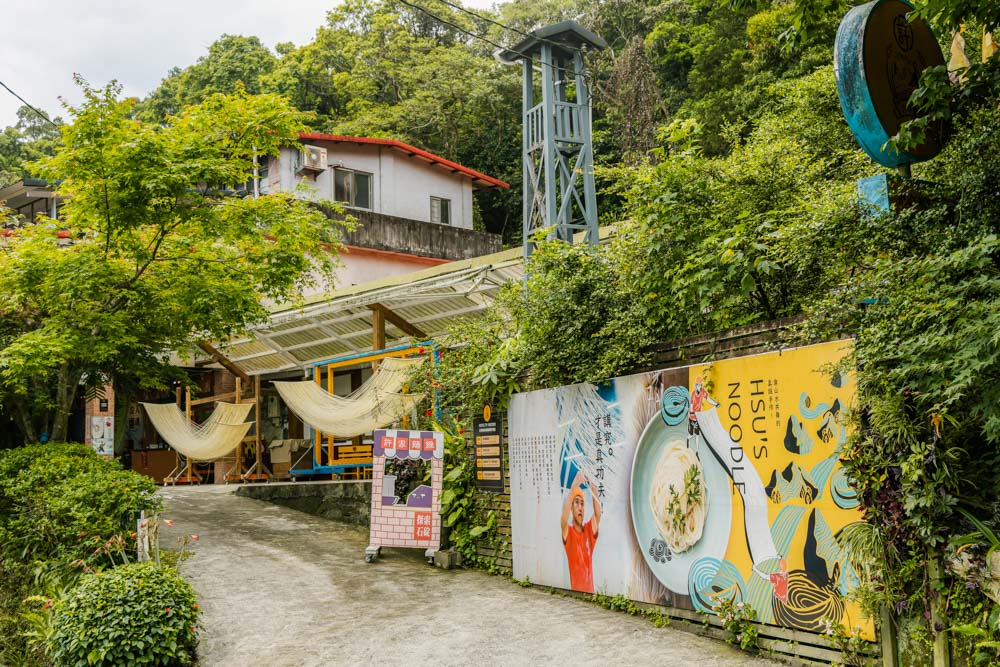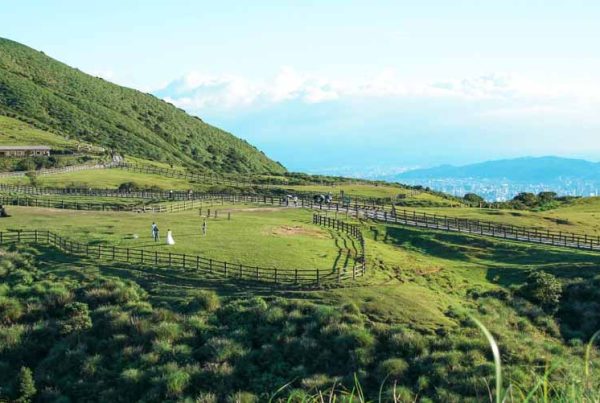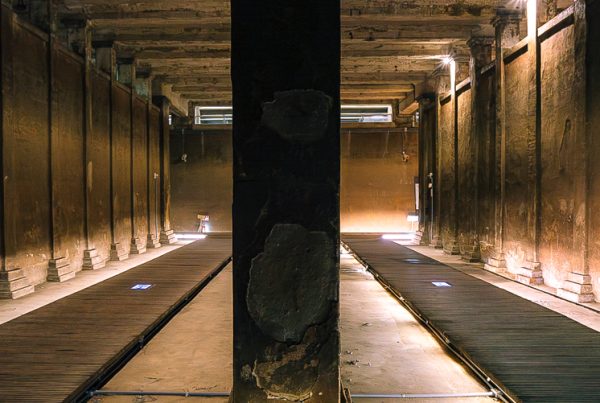Traditional Noodle Making in New Taipei City’s Shiding District
TEXT / OWAIN MCKIMM
PHOTOS / CHEN CHENG-KUO
Stringy, chewy, and delicately savory, mianxian, or wheat vermicelli, is one of Taiwan’s most popular types of noodles. Though most mianxian on the market is mass-produced using modern machinery, the chewiest noodles are the ones still made the old-fashioned way. In the mountains southeast of Taipei City, one artisan, Hsu Jen-ping, has been making small-batch hand-pulled mianxian for almost thirty years.
As we leave Taipei City and head east into the mountains, the clouds promise rain. We pass through Shiding – a quaint village straddling a winding gorge-bottom river – now heading southeast, and begin to climb an ever steeper, ever more twisting mountain road, scattered with the tung blossoms of late spring. Following a fork with a sign for Hsu’s Noodle, the clouds break, and as we pull up outside the small workshop we are greeted with the sight of mianxian, draped over wooden frames, shining like golden hair in the sun.


Most visitors to Taiwan will likely encounter mianxian as part of the famous oyster vermicelli –roasted mianxian topped with oysters, garlic, and coriander in a thick, starchy soup – which can be easily found at day markets and in night markets around Taiwan. This is, however, far from being its only culinary application, one other particular local favorite being mianxian served with ham hocks as an auspicious birthday meal, the long noodles symbolizing long life.
Mr. Hsu, a stocky man in early middle age sporting an orange bandana and a warm smile, greets us in the courtyard of what was his childhood home, now a welcome area for visitors, beside which is the small production area – a simple corrugated-iron-roofed building Hsu set up in 1996 after deciding that making hand-pulled mianxian was his calling.

“My family originally were tea growers,” Hsu says, “but when still young I already knew that I didn’t want to go into the tea-producing business. Picking tea is tedious, back-breaking labor.” So, after graduating from junior high school, Hsu apprenticed with his neighbor, a mianxian producer, from whom he learned the tricks of the noodle-making trade. “After two years of learning to make noodles, I went back to finish my education and got a job as a technician fixing banking machines. After a couple of years of that, though, I felt I was in a rut.” At a loss for how to increase his prospects, Hsu sought advice from his former master, who, perhaps unsurprisingly, suggested he start his own noodle-making business. Convinced, and with his family’s blessing, Hsu added a small workshop as an extension to his family home and began producing mianxian the traditional way.
“My family originally were tea growers, but when still young I already knew that I didn’t want to go into the tea-producing business. Picking tea is tedious, back-breaking labor.”
For Hsu, the eight-to-nine-hour process of making mianxian starts before dawn, when he and his small team prepare the dough – a mixture of water, salt, and plain wheat flour – before kneading and pressing, a process which Hsu completes using circular wooden boards and his body weight, pounding the top board with his feet to compress the dough sandwiched between. He then takes a hooked knife and, starting at the outer edge, cuts this dough pancake into a spiral until it resembles a pale, coiled snake. These coils, about the thickness of a man’s arm, are then unwound, rolled until their diameter is more akin to that of a finger, and finally looped around two metal poles in a figure-of-eight. The next and penultimate step before the final drying is the pulling of the noodles, and this is one that visitors to the workshop can try out for themselves.

Pulling the noodles requires two people. One holds the two metal rods around which the noodles are looped. The other takes a third metal rod, places it between the strands at their lowest dipping point, and, holding onto both ends, takes a few paces backward. Then, facing each other with the noodles slack between them, the two engage in a rhythmic back and forth whereby the noodles are alternately stretched and relaxed with jerky, undulating motions. It’s this specific technique, Hsu says, that gives hand-pulled mianxian their superior texture – which in Taiwan is known as “Q” (a bouncy, chewy mouthfeel beloved by the Taiwanese and familiar to anyone who has chewed on the tapioca pearls in a Taiwanese bubble tea.)
When Hsu started making noodles, it was a two-person operation – just Hsu and his father, who were able to process around five sacks of flour a day. Almost thirty years later, the number of staff has increased, but the production scale remains relatively small, with only around 20 sacks of flour being processed per day at peak times. However, with such a limited output, quality control is of course extremely high, in part because of the care that Hsu puts into his production, but also because of the location. “The recipe for mianxian is so simple – water, salt, and flour,” Hsu says, “that the quality of the water is incredibly important and has a big influence on the noodle’s texture, as does the air quality for when we dry the noodles in the sun. Being outside of the city, in the mountains, so close to the natural world, we can avoid any pollutants adulterating the texture and flavor of our noodles.”
“The recipe for mianxian is so simple – water, salt, and flour – that the quality of the water is incredibly important”
After pulling the noodles, visitors can test the “Q-ness” of Hsu’s mianxian for themselves. At the rear of the courtyard, four water chutes are set up with benches arranged alongside. At Hsu’s instigation, mouthfuls of noodles are sent sliding down the chutes at regular intervals. Participants take a pair of chopsticks and try to catch them as they whoosh by. The process begins with plain noodles, but after a few mouthfuls have passed, the plain noodles are followed by pink ones – flavored with red yeast – and soon after that by green ones – flavored with green tea. The flavors are subtle, but indeed, the texture is what stands out – chewy and bouncy, with a mildly fermented aftertaste, a truly pleasing mouthfeel.


Visitors are free to show up any time during opening hours, but to take part in the activities (pulling noodles: NT$300 per person; water chute noodles: NT$250 per person), Hsu recommends booking ahead of time. Packets of the noodles in all three flavors are also available for purchase at just NT$75 each – one packet contains two portions. To get to the workshop, having one’s transportation (such as a taxi or rental car) is best; however, it is possible to take the number 666 bus from MRT Jingmei Station (Green Line of Taipei Metro) to Shiding, and to walk the 3km uphill from there (while the trek may be strenuous, the views of deep valleys and the surrounding mountains are quite stunning). Alternatively, trips to Hsu’s Noodle can be booked as part of day-trip packages by various local tour companies.

Hsu’s Noodle
(許家麵線)
Add: No. 3, Sifenzi, Wutu Borough, Shiding District, New Taipei City
(新北市石碇區烏塗里四分子3號)
Tel: (02) 2663-3004
FB: www.facebook.com/sdnoodles







